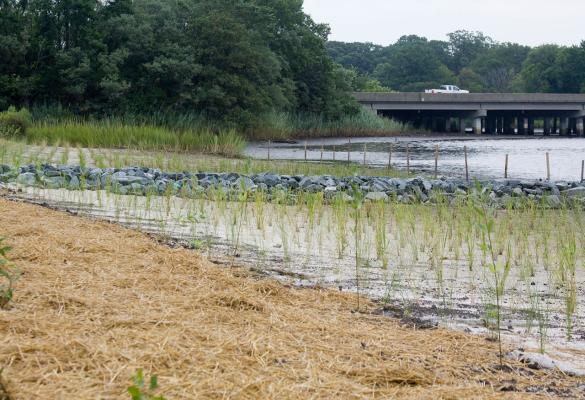Coastal Marsh Restoration
Coastal marshes, also frequently called salt marshes, are partially flooded wetlands that are inundated by salt water brought in by the tides but can vary in salinity levels (NOAA 2023). They occur where fine sediments accumulate along shoreline protected from the open ocean. Halophytes (salt-tolerant species) dominate the ecosystem, especially smooth cordgrass and saltmarsh hay on the Atlantic and Gulf coasts and American glasswort, California cordgrass, and big bulrush on the Pacific Coast of the United States (Zedler et al. 2008). Around half of coastal marshes globally have been lost or significantly degraded (DiGiacomo 2020). Prominent drivers of this decline include polluted stormwater runoff, erosion, invasive species, drought, and sea level rise (Morganello 2021). Coastal marsh restoration varies regionally, but typically includes isolating an area via dikes and pumping in sediment, planting native vegetation, and diverting nearby rivers to flow through the marsh (Olander et al. 2021).

Case Studies
Bair Island Restoration Project
Bar Beach Salt Marsh Restoration, Hempstead Harbor
Barataria Basin Ridge and Marsh Creation Project: Spanish Pass Increment
Bayou La Branche Wetlands Restoration (St. Charles Parish)
Chesapeake Bay Nutria Eradication Project
Commerical Township Salt Hay Farm
Constructed Marsh With Breakwaters: Mobile Bay, Alabama
Deer Island Aquatic Ecosystem Restoration
Dredged Sediment in an Uncontrolled Diversion
Dutch Slough Tidal Marsh Restoration
Florida Cat Point Living Shoreline Project
Florida Pensacola Bay Living Shoreline Project
Grande Cheniere Ridge Marsh Creation
Herring River Tidal Restoration Project
Island Road Marsh Creation & Nourishment
Kenilworth Marsh Tidal Wetland Restoration, Washington D.C.
Kerry Island Esturary Restoration
Lavaca Bay Restoration, Point Comfort, Calhoun County
Louisiana Outer Coast Restoration
MacDill Oyster Reef Shoreline Stabilization
Maidford River Saltmarsh Restoration: Middletown, Rhode Island
Marsh Enhancement With Toe Protection: Great Egg Harbor Bay, NJ
Marsh Island (Portersville Bay) Restoration Project
Maryland Analyzes Coastal Wetlands Susceptibility to Climate Change
Mile Point Wall Reconfiguration
Narrow River Estuary Resiliency Restoration
Narrow River Restoration Project
Northern Mississippi River Delta, Louisiana
Paul J. Rainey Widllife Sanctuary
Prime Hook National Widllife Refuge
Restoration of Diamondback Terrapin Nesting Habitat along the Potowomut River
Restoring Bolsa Chica Wetlands
Restoring Tidal Wetlands at Sonoma Baylands, San Francisco Bay
Sachuest Point National Wildlife Refuge
Salt Marsh Restoration on Barren Island in Chesapeake Bay
Saving Tidal Marshes in the San Francisco Bay
Seal Beach Restoration Project
Sears Point Wetland Restoration
Sediment Strategy Seeks to Save Salt Marsh Species
South Bay Salt Pond Restoration Project
South Slough National Estuarine Research Reserve
Southern Mississippi River Delta, LA
Southwest Florida Assesses Salt Marsh Vulnerability to Sea Level Rise
Tools
Gulf of Maine Association Project Planning: Salt Marshes
Impacts of Sediment Removal from and Placement in Coastal Barrier Island Systems
Maintaining Salt Marshes in the Face of Sea Level Rise - Review of Literature and Techniques
Mitigation Action Portfolio (MAP)
New York City Parks Salt Marsh Restoration Design Guidelines
New York State Salt Marsh Restoration and Monitoring Guidelines
Promoting Nature-Based Hazard Mitigation Through FEMA Mitigation Grants
Research Needs for Coastal Green Infrastructure
Use of Natural and Nature-based Features (NNBF) for Coastal Resilience
Likely Benefits and Outcomes
This strategy is likely to achieve these project goals. Click to search for strategies with a similar benefit.
Related Green (natured-based) vs. Gray infrastructure
Explore opportunities to replace or supplement gray infrastructure with green infrastructure options.
